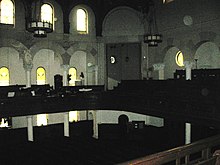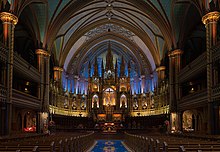Sanctuary

A sanctuary, in its original meaning, is a sacred place, such as a shrine. By the use of such places as a haven, by extension the term has come to be used for any place of safety. This secondary use can be categorized into human sanctuary, a safe place for people, such as a political sanctuary; and non-human sanctuary, such as an animal or plant sanctuary.
Religious sanctuary
Sanctuary is a word derived from the Latin
Sanctuary as area around the altar
In many Western Christian traditions including Catholic, Lutheran, Methodist, and Anglican churches, the area around the altar is called the sanctuary; it is also considered holy because of the belief in the physical presence of God in the Eucharist, both during the Mass and in the church tabernacle at other times.
In many churches the architectural term
In many Western traditions,

The terminology that applies the word sanctuary to the area around the altar does not apply to Christian churches alone:
There is a raised
Sanctuary as a sacred place
In Europe, Christian churches were sometimes built on land considered to be a particularly holy spot. Often these there were legends associated with these locations regarding miracles or martyrdom believed to have taken place or where a holy person was buried. Examples are
The place and the church built there were considered to have been sanctified (made holy) by what happened there. In modern times, the
Human sanctuary

Traditions of Sanctuary
Although the word "sanctuary" is often traced back only as far as the Greek and Roman empires, the concept itself has likely been part of human cultures for thousands of years. The idea that persecuted persons should be given a place of refuge is ancient, perhaps even primordial, deriving itself from basic features of human altruism. In studying the concept across many cultures and times, anthropologists have found sanctuary to be a highly universal notion, one which appears in almost all major religious traditions and in a variety of diverse geographies. "Cities of refuge" as described by the Book of Numbers and Deuteronomy in the Old Testament, as well as the Bedouin idea of nazaala, or the "taking of refuge", indicate a strong tradition of sanctuary in the Middle East and Northern Africa. In the Americas, many native tribes shared similar practices, particularly in the face of invading European powers. Despite tensions between groups, many tribes still offered and received sanctuary, taking in those who had fled their tribal lands or feared persecution by the Spanish, English, and French.[2]
Legal sanctuary
Some (but not all) temples offered sanctuary to criminals or runaway slaves.[3] When referring to prosecution of crimes, sanctuary can mean one of the following:

Church sanctuary
A sacred place, such as a church, in which fugitives formerly were immune to arrest (recognized by English law from the fourth to the seventeenth century).[4][5] While the practice of churches offering sanctuary is still observed in the modern era, it no longer has any legal effect and is respected solely for the sake of tradition.[6]
The term 'sanctuary' is also used to denote the part of the church which contains the main, or "high altar".
Political sanctuary
Immunity to arrest afforded by a sovereign authority. The United Nations has expanded the definition of "political" to include race, nationality, religion, political opinions and membership or participation in any particular social group or social activities. People seeking political sanctuary typically do so by asking a sovereign authority for asylum.
Right of asylum

Many ancient peoples recognized a religious right of asylum, protecting those accused of a crime from legal action and from exile to some extent. This principle was adopted by the early Christian church, and various rules developed for what the person had to do to qualify for protection and just how much protection it was.
Based on an account by
Political asylum
During the
In 1470, when the Lancastrians briefly restored
In the 20th century, during
In 1939, months before
In 1970,
Ten years later,
Later in the 1980s,
Sanctuary versus asylum
The concepts of sanctuary and asylum are defined very similarly at their most basic level. Both terms involve the granting of safety or protection from some type of danger, often implied to be a persecuting, oppressive power. The divergence between these terms stems primarily from their societal associations and legal standing; while asylum understood in its political sense implies legally-binding protection on the part of a state entity, sanctuary often takes the form of moral and ethical activism that calls into question decisions made by the institutions in power.[10]
In many instances, the sanctuary is not incorporated into the law but operated in defiance of it. Efforts to create a sanctuary for the persecuted or oppressed are often undertaken by organizations, religious or otherwise, who work outside of mainstream avenues to ameliorate what they see as deficiencies in the existing policy. Though these attempts to provide sanctuary have no legal standing, they can be effective in catalyzing change at community, local, and even regional levels. Sanctuary can also be integrated into these levels of government through "Sanctuary bills", which designate cities and sometimes states as safe spaces for immigrants deemed illegal by the federal government. These bills work to limit the cooperation of local and regional governments with the national government's efforts to enforce immigration law. In recognition of their progressiveness and boldness in the face of perceived injustice, "Sanctuary bills" are commonly referred to as "activist law".[11]
Sanctuary in contemporary society
For the last few centuries, it has become less common to invoke sanctuary as a means of protecting persecuted peoples. Yet, the 1980s saw a massive resurgence of cases as part of the U.S.-Central American sanctuary movement. This resurgence was part of a broader anti-war movement that emerged to protest U.S. foreign policy in Central America. The movement grew out of the sanctuary practices of political and religious organizations in both the United States and Central America. It was initially sparked by immigrant rights organizations in well-established Central American communities. These organizations first opposed U.S. foreign policy in Central America and then shifted towards aiding an ever-increasing number of Central Americans refugees. Working in tandem, immigrant rights organizations and churches created many new organizations that provided housing and legal services for newly arrived immigrants. These organizations also advocated for the creation of sanctuary spaces for those fleeing war and oppression in their home countries. By 1987, 440 cities in the United States had been declared "sanctuary cities" open to migrants from civil wars in Central America.[12]
The immigrant-religious organization partnerships of the sanctuary movement remain active, providing essential services to immigrant populations. Particularly notable in recent years is their legal and advocacy work. By providing legal representation to asylum seekers who may not be able to afford it, these organizations give their clients a better chance of winning their respective cases. As of 2008, detained asylum seekers with legal representation were six times more likely to win their cases for asylum, and non-detained asylum seekers with representation were almost three times more likely to win asylum compared with those without it.[2] The pro bono legal services provided by these organizations also work to alleviate stress on an adjudication system that is already overloaded with cases—a 2014 study of the system showed that about 250 asylum officers at any one time are tasked with interviewing an average of 28,000 asylum seekers.[13] These sanctuary-based organizations also engage in larger-scale advocacy work that allows them to reach immigrant populations beyond the communities they work in. According to a study done by the "New Sanctuary Movement" organization, at least 600,000 people in the United States have at least one family member in danger of deportation.[14] Legislative and judicial advocacy work at the regional and even national level allows organizations to support this group of people by influencing policy.
From the 1980s continuing into the 2000s, there also have been instances of immigrant rights organizations and churches providing "sanctuary" for short periods to migrants facing deportation in Germany, France, Belgium, the Netherlands, Norway, Switzerland, Australia and Canada, among other nations. In 2007, Iranian refugee Shahla Valadi was granted asylum in Norway after spending seven years in church sanctuary after the initial denial of asylum.[15] From 1983 to 2003 Canada experienced 36 sanctuary incidents.[16] In 2016, an Icelandic church declared that they would harbor two failed asylum seekers who violated the Dublin Regulation, and police removed them for deportation, as ecclesiastical immunity has no legal standing.[17]
Other uses
When referring to a shelter from danger or hardship, sanctuary can mean one of the following:
- Shelter sanctuary
- A place offering protection and safety; a shelter, typically used by refugees, and homeless people.
- Humanitarian sanctuary
- A source of help, relief, or comfort in times of trouble typically used by victims of war and disaster.
- Institutional sanctuary
- An institution for the care of people, especially those with physical or mental impairments, who require organized supervision or assistance.
- Work Sanctuary
- A place where an individual can work safely and in a natural environment
The term "sanctuary" has further come to be applied to any space set aside for private use in which others are not supposed to intrude, such as a "man cave".
Non-human sanctuary
Animal sanctuary
An animal sanctuary is a facility where animals are brought to live and be protected for the rest of their lives. Unlike animal shelters, sanctuaries do not seek to place animals with individuals or groups, instead maintaining each animal until its natural death.
Plant sanctuary
Plant sanctuaries are areas set aside to maintain functioning natural ecosystems, to act as refuges for species and to maintain ecological processes that cannot survive in most intensely managed landscapes and seascapes. Protected areas act as benchmarks against which we understand human interactions with the natural world.
See also
References
- ISBN 9788189093129.
In the historic floor plan, the words chancel and sanctuary are often synonymous.
- ^ ISBN 978-0-295-99914-2.
- ^ Ciappara, Frans (1985). "Non gode l'immunita ecclesiastica" (PDF). Melita Historica. 9 (2): 117–132. Archived from the original (PDF) on 16 April 2016.
- ^ "Sanctuary, Violence, and Law in Late Medieval England - Virtual seminar (abstract)". Worldwide Universities Network. 24 May 2010. Archived from the original on 26 August 2014.
- ^ Hanna, Jason (2017-02-17). "Can churches provide legal sanctuary to undocumented immigrants?". CNN. Retrieved 2022-05-09.
- ISBN 978-0-14-190853-3.
- ^ Geoffrey of Monmouth, Historia Regum Britanniae 2, 17
- Encyclopædia Britannica Online.
- OCLC 250576716.
- ISSN 2574-1306.
- . Retrieved 2020-05-16.
- OCLC 995330858.
- ^ "Immigration Activist Arrested Outside L.A. Church". Associated Press. Aug 20, 2007. Archived from the original on August 20, 2007 – via Library of Congress Web Archives.
- ^ "Iranian given asylum in Norway". News24.com.
- ISBN 0-7748-1249-4.
- ^ "Asylum seekers dragged out of church by Reykjavík Police".
Further reading
- J. Charles Cox (1911). The Sanctuaries and Sanctuary Seekers of Medieval England On Archive.org
- John Bellamy (1973). Crime and Public Order in England in the Later Middle Ages.
- ISBN 0-684-16760-3
- Jean Calmard (1988). "Bast (sanctuary, asylum)". Encyclopædia Iranica.
External links
- Sanctuary Movement history on New Standards
- Sanctuary in church architecture – from the Catholic Encyclopedia
- Sanctuary as a place of refuge – from the Catholic Encyclopedia
